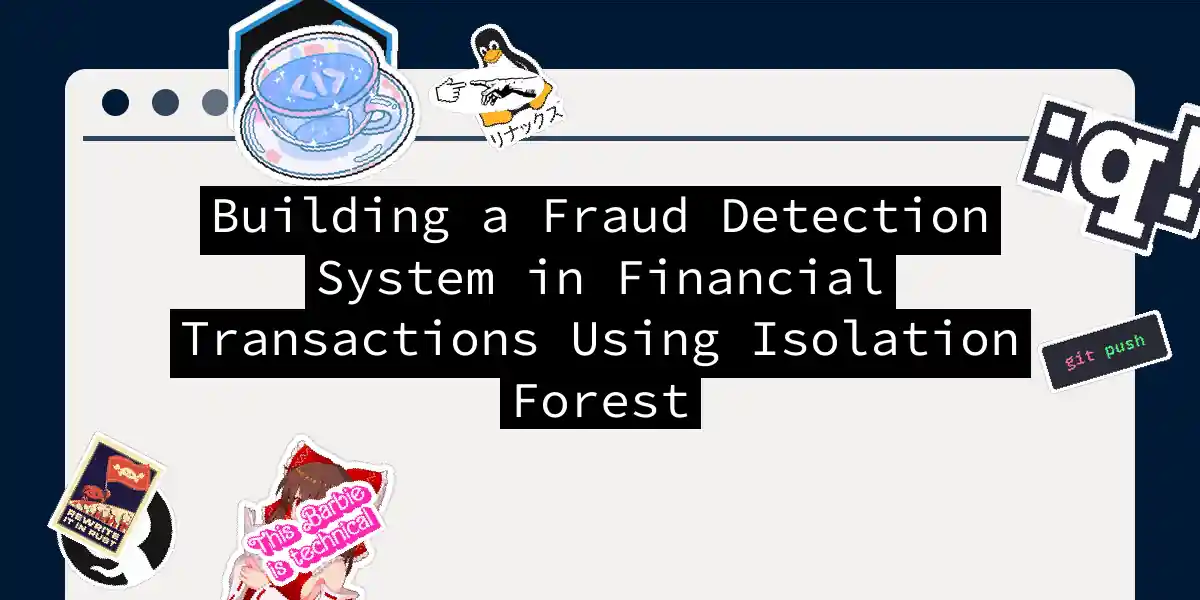Introduction to Fraud Detection
In the world of finance, fraud is a constant and evolving threat. As technology advances, so do the methods of fraudsters, making it a cat-and-mouse game between them and the financial institutions. One of the most effective ways to combat fraud is through the use of machine learning algorithms, particularly the Isolation Forest.
What is Isolation Forest?
Isolation Forest is an unsupervised learning algorithm designed to identify anomalies or outliers in a dataset. It works by creating multiple decision trees that partition the data, and the idea is that anomalies will be isolated more quickly than normal data points. This makes it an excellent choice for detecting fraudulent transactions, which often stand out as anomalies in financial data.
Why Use Isolation Forest for Fraud Detection?
Advantages Over Traditional Methods
Traditional methods of fraud detection often rely on rule-based systems or supervised learning models. However, these methods have several drawbacks:
- High False Positive Rates: Rule-based systems can generate a lot of false positives, which can be costly and annoying for legitimate customers.
- Class Imbalance: Supervised learning models suffer from class imbalance issues, where the number of legitimate transactions far exceeds the number of fraudulent ones.
Isolation Forest, being an unsupervised algorithm, does not require labeled data and can handle class imbalance more effectively.
Real-Time Detection
Isolation Forest can be used for real-time detection of fraudulent transactions. Since it does not require extensive training data or complex model tuning, it can be integrated into existing transaction processing systems to flag suspicious transactions immediately.
Step-by-Step Guide to Implementing Isolation Forest
Data Preparation
Before diving into the implementation, you need to prepare your data. Here are some steps to follow:
- Collect Transaction Data: Gather a dataset of financial transactions. This can include features such as transaction amount, time of day, location, user ID, etc.
- Feature Engineering: Extract relevant features from the transaction data. For example, you might calculate the average transaction amount per user, the frequency of transactions, or the distance between transaction locations.
- Data Cleaning: Clean the data by handling missing values, removing duplicates, and normalizing the features.
Implementing Isolation Forest
Here is a simple example using Python and the scikit-learn library:
from sklearn.ensemble import IsolationForest
import pandas as pd
import numpy as np
# Load your dataset
data = pd.read_csv('transactions.csv')
# Select the features you want to use
features = data[['transaction_amount', 'time_of_day', 'location', 'user_id']]
# Initialize and fit the Isolation Forest model
iforest = IsolationForest(contamination=0.01)
iforest.fit(features)
# Predict anomalies
anomaly_scores = iforest.decision_function(features)
anomaly_labels = iforest.predict(features)
# Anomaly labels will be -1 for anomalies and 1 for normal data points
anomalies = features[anomaly_labels == -1]
Integrating with Real-Time Systems
To integrate this model into a real-time system, you can use a streaming data processing framework like Apache Kafka or a message queue like RabbitMQ. Here’s a high-level overview of how this could work:
Handling False Positives and False Negatives
While Isolation Forest is effective, it is not perfect and can still generate false positives and false negatives. Here are some strategies to mitigate these issues:
- Threshold Tuning: Adjust the contamination parameter in the Isolation Forest model to balance between false positives and false negatives.
- Additional Validation: Implement additional validation steps for transactions flagged as anomalies. For example, a human reviewer could verify the transaction before it is blocked.
- Feedback Loop: Implement a feedback loop where transactions that are incorrectly flagged can be labeled and used to retrain the model.
Example Use Case
Let’s consider a real-world example where a bank wants to detect fraudulent credit card transactions. Here’s how the process might look:
Data Collection
The bank collects transaction data including the amount, time, location, and user ID.
Feature Engineering
The bank calculates additional features such as the average transaction amount per user, the frequency of transactions, and the distance between transaction locations.
Model Training
The bank trains an Isolation Forest model on the historical transaction data.
Real-Time Detection
When a new transaction comes in, the model processes it and flags it as an anomaly if it deviates significantly from the normal behavior.
Alert and Review
If a transaction is flagged, the system sends an alert to the bank’s fraud monitoring team, who can then review the transaction and take appropriate action.
Conclusion
Building a fraud detection system using Isolation Forest is a powerful way to protect financial transactions from fraud. By leveraging the strengths of unsupervised learning, you can create a system that is both effective and efficient. Remember, the key to success lies in careful data preparation, model tuning, and continuous improvement through feedback loops.
As you embark on this journey, keep in mind that fraud detection is an ongoing battle, and staying one step ahead of the fraudsters requires constant innovation and vigilance. But with the right tools and a bit of creativity, you can turn the tables and make your financial systems safer and more secure.
